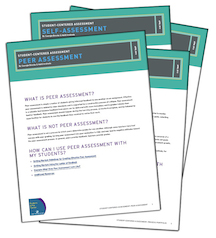 What is student-centered assessment? What is it not? How is it implemented in the classroom, and when implemented, what is the impact? These print and video resources illustrate the practical application of the research outlined in Assessing Learning. They focus on four student-centered assessment practices: self-assessment, peer assessment, exhibitions, and process portfolios.
What is student-centered assessment? What is it not? How is it implemented in the classroom, and when implemented, what is the impact? These print and video resources illustrate the practical application of the research outlined in Assessing Learning. They focus on four student-centered assessment practices: self-assessment, peer assessment, exhibitions, and process portfolios.
Student-Centered Assessment Guides
These simple guides can help any teacher begin implementing these student-centered assessment practices in their classroom.
Self-assessment is simply a matter of having students identify strengths and weaknesses in their own work and revise accordingly. Effective self-assessment involves students comparing their work to clear standards and generating feedback for themselves about where they need to make improvements. This guide provides a clear definition and steps for implementing self-assessment effectively in the classroom. It looks specifically at the use of rubrics and checklists and provides examples of each.
Peer assessment consists of students giving informed feedback to one another on an assignment. Effective peer assessment is related to clear standards and is supported by a constructive process of critique. This guide provides a clear definition and steps for implementing peer assessment effectively in the classroom. It looks specifically at the use of The Ladder of Feedback technique and provides an example.
A process portfolio is a purposeful collection of student work that documents student growth from novice to master. Successful process portfolios actively engage students in their creation, especially in determining their goals, selecting work to be included, and reflecting on how each piece demonstrates progress toward their goals. This guide provides a clear definition and steps for implementing process portfolios effectively in the classroom. It provides links to online examples of portions of students’ portfolios including a personal statement, a student reflection of development in written communication, and a full biology process portfolio.
An exhibition is a high-stakes demonstration of mastery that occurs at a culminating academic moment, such as the end of a school year or at graduation. Exhibitions are summative assessments, but the process of building up to a final exhibition includes ongoing assessment, feedback, and revision. This guide provides a clear definition, outlines components of effective exhibitions, and details the supportive conditions needed to implement them. It also provides links to several examples.
Student-Centered Assessment – Video Resources
These videos produced by the Students at the Center project, in conjunction with Dr. Heidi Andrade, Ed.D., and the students and teachers from IS 223 (Brooklyn, NY), show student student-centered assessment in practice.
The first video, Student-centered Assessment Jeopardy, serves as an introduction to the series. Three contestants tackle questions on the particulars of self- and peer assessment. This animation is a great introduction for teachers and students alike.
The next two videos in the series depict ISS 223 students and teachers engaging in and reflecting on student-centered self- and peer assessment. Learn how to effectively implement self- and peer assessment in your classroom and hear how what your students can gain from these practices.
In the final video, Dr. Heidi Andrade, Ed.D. defines the key components of self- and peer assessment and explains why should you try it in your classroom.
|
|
|
|